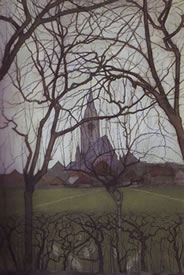
|
|
|
|
|
|
|
|

dorpskerk (village church); jacobskerk, winterswijk 1898 |
From 1895-1905 Piet Mondrian painted mainly landscapes, but also portraits and still lifes in a dutch impressionist manner. In 1898 Piet Mondrian was unsuccessful in his entry to the prix de Rome competition which centers on academic figure painting. He visited Winterswik, where he did work in a proto—symbolist manner. | |||

Wood with Beech Trees, 1899 |
Piet Mondrian’s interest in the vertical and massing of shapes could have been seen early on, during that period he had also painted many architectonic landscapes, including farmhouse, churches and farm animals. | |||

Stammer Mill with Streaked Sky, 1905-07. |
In January 1905 after painting for a year in rural Uden, Piet Mondrian returned to Amsterdam, living in a entertainment district. He visited the Van Gogh retrospective at the Stedelijk Museum. From 1906-1907 Mondrian painted a series of evening lanscapes. Already noticeable are strong horizontals and bands of color. Details had become forms rather than pictorial nuances, expression of light, color and space were studied. | |||

Row of Eleven Poplars in Red, Yellow, Blue and Green, 1908 |
In 1907 Piet Mondrian spent the summer in Oele. He saw Van Dongen (fauvist), Sluyters and Otto van Rees painting at Vierjaarlijke exhibition, National Salon in the fall. After this Mondrian continued to paint evening landscapes with a strong contrast of light and shadow, the horizon of the landscape creating bands of color. He started to use more primary colors at this time as well, moving increasingly towards abstraction, his brushstrokes become varied. Large areas of color were seen together with a staccato-pointalist style of painting. | |||
| Throughout his lifetime Piet Mondrian moved back and fourth from Holland to Paris onto to London and finally New York, moving either because of his need to place himself within a certain social complexity that would evidently also change painting style, or moving because of the treat of foreshadowing war thru both WWI and WWII. Along his way he acquired a language of many styles, evolving his own work with an incredible lineality. Learning to paint in a style of lassic Dutch realism, he painted portraits, still life’s, and naturalist landscapes. He learned new styles with incredible speed and understanding, often painting better than his colleagues and even masters. His work quickly moved thru luminist, and divisionist phases to abstract expressionist, pointillist, and cubist,finally ending with his well-known primary colored neoplastic phase, or new image phase.Mondrian was also a very eloquent writer, and visionary, writing several articles on his theories of the combining of all the arts. He wrote of a new world where all the arts including: painting, sculpture, architecture, music, theater would combine as one entity called the new image, the neo-plastic (neoplasticism). He was partly responsible for creating De Stijl (the style) magazine, a collective of mainly artists and architects who wanted modernism to become a well-known international idea and practice. Mondrian’s work would help from design schools such as the Bauhaus, and end up having a tremendous effect on the arts from graphic design to fashion and architecture. | ||||
| © 2002—2025 Mondrian/Holtzman Trust. All rights reserved. | Web Design by Enterprise Computer, LLC |